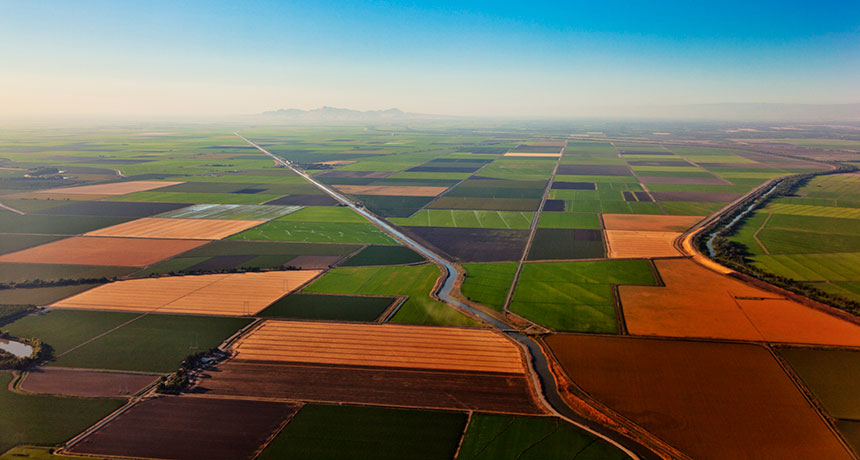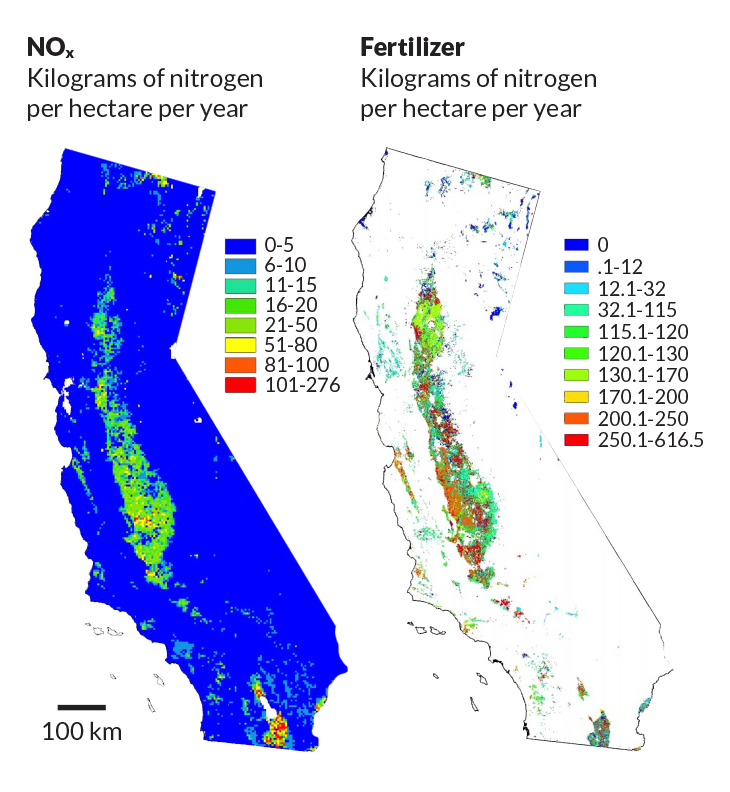Gassy farm soils are a shockingly large source of these air pollutants
Smog-causing nitrogen oxide gases aren’t only found in auto exhaust

FIELD FUMES California’s agricultural regions are responsible for between 20 and 51 percent of the total emissions of nitrogen oxide gases in the state, new research finds. Such “NOx” gases, which include nitric oxide and nitrogen dioxide, help produce toxic smog.
slobo/iStockphoto
- More than 2 years ago
California’s crops are creating some noxious air.
The Golden State is at the vanguard in the United States in reducing auto emissions of nitrogen oxide gases, which help produce toxic smog and acid rain. But the NOx pollution problem isn’t limited to auto exhaust. California’s vast agricultural lands — particularly soils heavily treated with nitrogen fertilizers — are now responsible for as much as 51 percent of total NOx emissions across the state, researchers report January 31 in Science Advances.
The catchall term “NOx gases” generally refers to two pollution-promoting gases: nitric oxide, or NO, and nitrogen dioxide, or NO2. Those gases react with incoming sunlight to produce ozone in the troposphere, the lowest layer of the atmosphere. At high levels, tropospheric ozone can cause respiratory problems from asthma to emphysema.
Between 2005 and 2008, regulations issued by the California Air Resources Board on transportation exhaust reduced NOx levels in cities such as Los Angeles, San Francisco and Sacramento by 9 percent per year. However, the U.S. Environmental Protection Agency has increasingly recognized nitrogen fertilizer use as a significant source of NOx gases to the atmosphere.
NOx gases are produced in oxygen-poor soils when microbes break apart nitrogen compounds in the fertilizer, a process called denitrification. The release of those gases from fertilized soils increases at high temperatures due to increased microbial activity, says Darrel Jenerette, an ecologist at the University of California, Riverside, who was not involved in the new study.
Jenerette and others have studied local NOx emissions from soils in California, but no statewide assessment existed. So Maya Almaraz, an ecologist at the University of California, Davis, and her colleagues designed a study to examine the question — both from above and below.
Using a plane equipped with scientific instruments including a chemiluminescence analyzer to detect NOx gases in the atmosphere, the researchers measured the concentrations of the gases above the San Joaquin Valley, an area of California’s fertile Central Valley, over six days at the end of July and beginning of August. The team also simulated NOx emissions from soils across the state, using the San Joaquin Valley data to ensure that the simulations gave accurate results. Finally, the researchers compared those data with nitrogen fertilizer inputs, as estimated by crop type and U.S. Department of Agriculture fertilizer consumption data.
Story continues below maps
Fertilized ground
Simulations revealed that California’s Central Valley had the highest emissions of NOx gases from soils in the state (left), closely matching the regions with the highest rate of nitrogen fertilizer use (right). 
Croplands are contributing 20 to 51 percent of the total NOx in California’s air, Almaraz’s team reports. In the simulations, those soil emissions were particularly sensitive to two factors: climate, especially temperature, and rates of nitrogen input. That findings suggests that regions with greater inputs of nitrogen fertilizer will also see greater soil emissions — and that the emission of NOx gases from the soils will also increase as temperatures rise in the region due to climate change.
Although food demands — and the need for fertilizer for crops — are likely to increase in the future, there are numerous possible ways to limit unwanted nitrogen fertilizer spillover, the researchers note. For example, farmers can use more efficient fertilization strategies such as adjusting how much fertilizer is used depending on specific growing stages, or planting what are called cover crops along with the target crops that enrich soils and consume the excess nitrogen.
Almaraz’s team has produced an important finding, Jenerette says. “The combination of bottom-up soil emission measurements and top-down airborne measurements provide strong evidence for their emission assessments,” he says. The finding that NOx emission rates will increase with warming temperatures also highlights the urgency of taking steps to better manage nitrogen fertilizer use in a warming world, he says.






